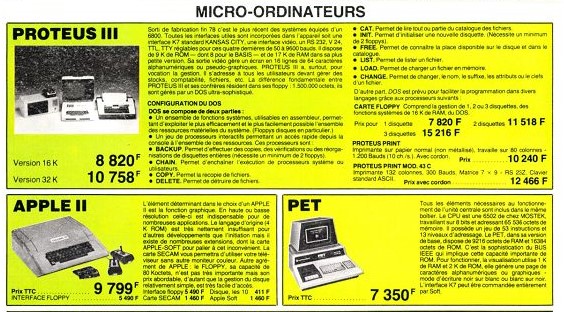Archive for the ‘fr-colditz’ Tag
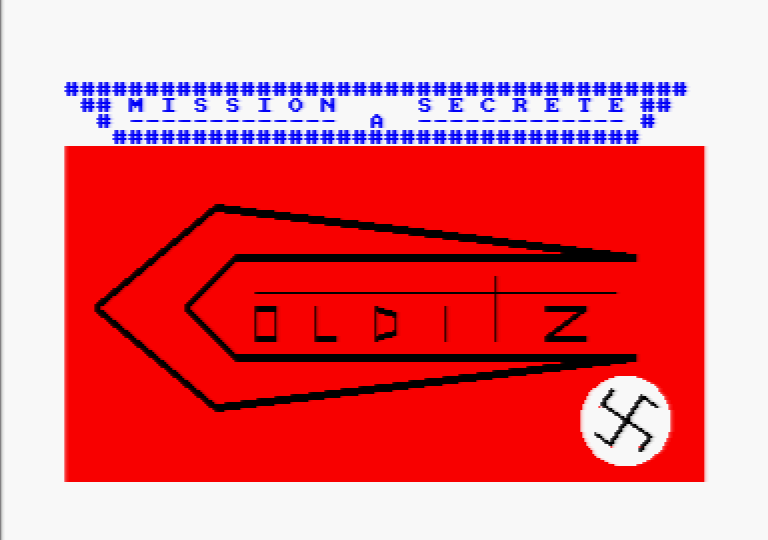
After World War II ended, Germany was split into four “occupation zones”, with Russia in the northeast, the UK in the northwest, France in the southwest, and the US in the southeast. The US, British, and French sections made up West Germany; the Russian section was East Germany.
This arrangement meant French military forces were stationed in Germany, which is important for our story.
(Before going on, I’ll preface that most of what follows comes from Hugo Labrande, who has extensive research on early French text adventures as well as interviews here, here and here.)
The author of today’s game, Marcel Le Jeune, got his start with electronics with a Texas Instruments calculator in the early 70s; his first computer was a PDP-8 he encountered while at French military school. He then went on as an electronic warfare specialist, being stationed in Germany from 1977 to 1982.
He had access there to American military bases and their duty-free shops, and thus was able to be a very early owner of a TRS-80 as well as get exposure to US magazines and software. He most particularly remembers the adventure game Pyramid of Doom, although it wasn’t necessarily officially obtained, as he had a Parisian friend who kept him supplied in tape copies sent by mail.
His early exposure to adventure games is likely what led him to be one of the first people from France to create an adventure game; in fact, since Bilingual Adventure was just a modified port of Crowther/Woods, we can say Mission secrète à Colditz is the first original adventure game in French. (That we know of. Making a statement like this invites being outdated in six months when something new comes up.)
While he wrote it in the 1979-1980 period (according to his memory) it wasn’t published, but rather sent to friends and demonstrated to both friends and family. Viewers were amazed at the flexibility of the parser (it’s a bit of a sneak, more on that in a moment) but Marcel was generally frustrated at the reception as people were stumped, and when he tried to help, the response was
Je n’aurais jamais pensé à faire ça!
that is, “I would never have thought of doing that!”
Much later — after returning to France — he became editor of the magazine CPC, dedicated to the Amstrad, and had Stéphane Cloirec port the source code directly from the TRS-80. There was also a version published in the pages of an Oric magazine. The TRS-80 source is lost so I went with the Amstrad version to play.

Now, since my French is terrible, I gave myself a little more advantage than I usually do straight from the beginning: I extracted the verb list. All of the verbs only have the first four letters, so I made my best guess as to what verbs match.
ALLE (aller = go)
PREN (prendre = take)
OUVR (ouvrir = open)
REMP (remplir = fill)
TUER (tuer = kill)
LIRE (lire = read)
ASSO (assommer = knock out)
DONN (donner = give)
DEMA (demander = ask)
COUP (coup = cut)
ALLU (allumer = light up / turn on)
ETEI (eteindre = extinguish / turn off)
POSE (poser = drop)
JETE (jeter = throw)
MANG (manger = eat)
BOIR (boire = drink)
CASS (casser = break)
TOUR (tourner = turn)
(I works for Inventory and there’s also direction abbreviations. Feel free to point out any alternatives or outright mistakes, I’ve already made some edits based on comments.)
I mentioned some subterfuge in the parser. The game only looks at the first four characters for the verb and the end portion for the noun. That means there can be sentences and phrasings in the middle which are entirely ignored. Hugo Labrande also points out a finesse to account for the fact that in French, writing an adjective after the noun is normal: the game hand-checks nouns and possible noun-adjective pairs together in order to parse things correctly.
IF RIGHT$(R$,5)=”PINCE”OR RIGHT$(R$,14)=”PINCE COUPANTE”
Still unsure on the parser, I checked the first line (and only the first line) of a walkthrough, and it said
Ouvrir la porte du camion
that is, open the door of the truck, but OUVR CAMION works just as well. The practical upshot is the parser can ignore articles someone would normally use (parsing “prendre la lampe” ignores “la”). From what I gather (although I would appreciate a native speaker’s perspective) leaving out the “la” in “la lampe” feels much odder than leaving out “THE” when typing GET LAMP. So this keeps the coding simplicity of what is more-or-less a two word parser while accommodating the change in language.
However, notice the sample includes “la porte” (the door) which is totally unnecessary. I’m wondering if part of the issue with sampling the game for friends was that the author was “showing off” too much; having too many ways to communicate can make it difficult to teach how to play a regular text adventure.
The upshot of all this is I can just type VERB NOUN for commands and ignore everything else.
The game’s premise:
In 1943, we have been summoned to London about a secret mission; one of “our best agents”, Captain Jim O’Donnel, had been on a parachute mission to obtain secret codes allowing V2 rockets to be destroyed in-flight. While he was able to get the code he wasn’t able to send it, and has been locked away at the fortress of Colditz.
(For background on Colditz, I have this post about an entirely different Colditz game. Remember this was all written while the author was stationed in Germany!)
We are sent on a secret mission to Colditz to get this code. We’ve snuck into the castle by hiding in a truck, and
Il est un peu plus de 21 heures, la nuit est noir …
B O N N E C H A N C E !
(We arrive just after 21:00, the night is dark, good luck!)

I’ve prodded enough to at least make an initial map:
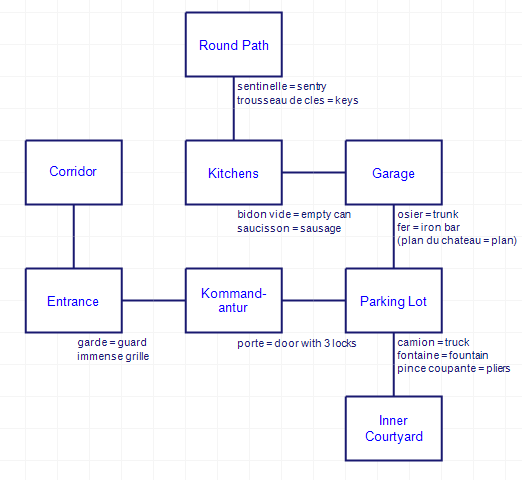
The “plan” that’s in the trunk just to the north of the starting room is unfortunately “old and all moldy” so doesn’t have any useful information.

The two spots with guards (Entrance, Round Path) haven’t raised any alerts yet, but I also haven’t tried to antagonize the guards, or try to poison sausage and feed it to them, or something like that.

Except for this. I tried to take the keys and the sentry woke up and killed me.
This might be a game I might normally take care of in one chunk in English but I’m willing to split into two or three parts here to give it the time it needs. I’m going to try to solve it as honestly as possible, but if all else fails I do have a full walkthrough so I can at least write about what’s supposed to happen even if my reaction is “Je n’aurais jamais pensé à faire ça!”
This game was printed as a type-in, twice. The Amstrad version was in CPC Magazine, starting from page 53.
As we’ve seen before with type-ins (I think most significantly from Spelunker out of Byte magazine) the actual version that gets passed on to various archives had to be typed in by someone first, and that means there might be a typo that carries on, especially if the person doing the typing never really played through the game in question.
I don’t think the person who typed in Colditz on the Amstrad played the game.

Via CPC Magazine, number 7.
(Also, before proceeding on further, special thanks to everyone who helped me through French difficulties. Unfortunately working through the language still doesn’t help with coding difficulties!)
Last time I left off on a sentry with some keys that I need to abscord with. I had already tried to “kill” the sentry with no luck, and “coup” (which in some circumstances be “hit”) didn’t work, but I hadn’t tried to mystery verb ASSO.
The entire list tended to the infinitive tense, so having sit which would normally be s’asseoir seemed to violate the rule but I couldn’t come up with a better verb than that. Still, I considered the verb to still be in the mystery zone, so I went ahead and tried it on the sentry and it worked.

ASSO turns out to be ASSOMMER (knock out). After you say you want to knock out the sentry it asks you what with, and you specify the “barre” (or “barre de fer” if you want the full “bar of iron”).
I was then able to nab the keys and run over to the locked door. This opened an area with four new rooms.

The first room has a safe, which asks for a combination if you try to open it. If you fail at the opening an alarm sounds. I don’t know the combination yet.

To the west there’s some guards who capture you. Probably this room should just be avoided.

To the south there’s a torture room, with a desk and a metal plate locked with a padlock. Here is where things went wrong, because I tried to break (casser) the padlock, and the game asked me with what, and I gave the iron bar again, and then:

I had to dig out the source code.


A quote mark symbol was supposed to be a parentheses (see above), so I was able to fix it. It could be a file corruption rather than a typo, but spotting one made me nervous about more. As it turns out, rightfully so, because the next room — an infirmary — had a broken lamp. Broken as in the game’s code, not the item itself.

No matter what I did, I could not refer to the lamp. Normally, I’d just pick it up, but the game claimed I couldn’t, and I was baffled enough I decided to peek at the walkthrough. Fortunately I didn’t spoil myself on anything, other than realize that if you try to follow the steps of the walkthrough, you are completely unable to pick up the lamp.
There must be another typo! Possibly more. I’m not sure if I really want to keep trucking with the Amstrad version, but I have been unable to download the Oric one (the site has some sort of security thing that doesn’t let me? or broken Javascript or something?) I may end up just having to blow any secrets and check the code line by line, but this admittedly follows the authentic type-in experience, where any players circa 1985 had to spoil themselves on the adventure by typing it in.
One of my readers, LanHawk, managed to sleuth out a different copy of the game sans typos, which I have archived here. I also managed to finish, and my previous posts on this game are needed to understand this one.

CPC Magazine, #7, pages 56 and 57.
So, returning to the moment of busting open a padlock, which crashed the game last time, I somehow didn’t notice there was also a passage to the east that opened.

However, I ignored that in favor of being able to take the lamp, which I wasn’t able to get last time. If you turn on the lamp and walk by the large gate at the exit with the guard, the guard spots you in the night.

So you want to wait until passing the guard safely into a corridor, where previously nothing was visible, but if you turn on the lamp, you see a previously missed door.

“Trap door” suggests this goes up, but once you cut the chains (the cutting pliers from the truck work) the exit that opens up is north.
Heading north, you can then find a small paper with a combination on it. This is the combination that works back on the safe (the one that previously sounded an alarm). Opening the safe yields a master key.

The entire map. Light blue are the rooms I hadn’t seen last time.
This was the end of the road for the moment. It turns out I needed to do one more thing and I could technically escape, but I hadn’t fulfilled the quest yet anyway, which was still to find the prisoner who had the code to blow up the rockets.
Now it was time to go in the new eastern route, the one unlocked by breaking the padlock…

…and die by falling in the dark on a staircase, oops! (“You had a deadly fall on the dark staircase.”) The lamp needed to be on, allowing visiting the final section of the game, an area of 5 rooms.

Stables just north of the staircase. There’s some rings attached to the wall, a portcullis blocking on our way back south, and a …trough, I think?
The small area has a room with some wood (not useful) a church with a candle and a rope (really not useful, especially the rope which rings a bell alerting guards), an office (useful, there’s a message about RING 1)…

…and the prisoner. The prisoner is thirsty. You can use the can from the start area and fill it with water in the fountain to take care of the thirst. (You’re not softlocked if you haven’t done this before entering the trapped area, since you can get out via means I’ll show in a moment.)

The prisoner — O’Donnel from the intro — says he knows “le code secret”. I had demander as a verb, so the next step was:
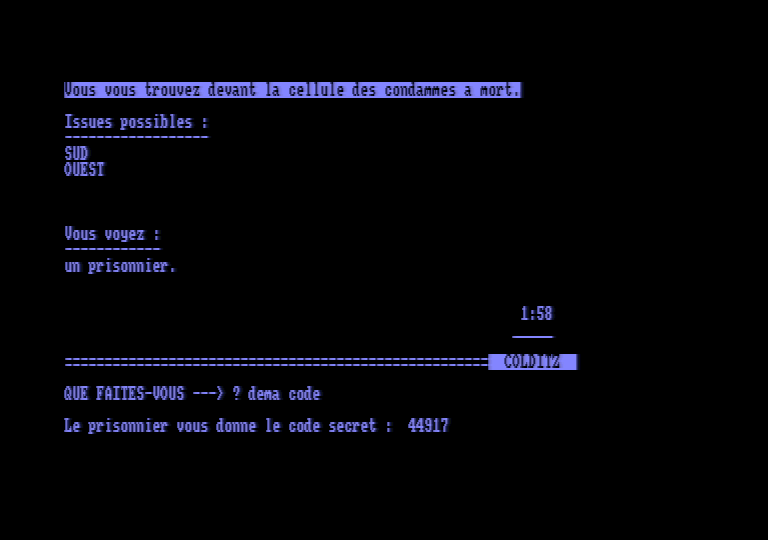
Blithely blowing past thinking about which article I should use in the French.
Now we just need to get out! The hint about the ring gets applied back in the stable, where you can turn the correct ring. (I think this is randomly generated, by the way, on each new game.) This opens a secret passage back to the Inner Courtyard.
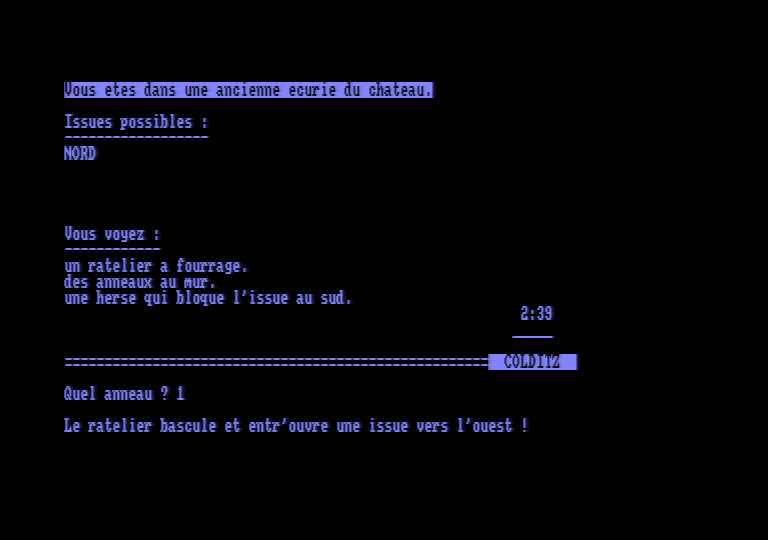
Escape now requires getting past the guard at the gate. Frustratingly, the “bonk with an iron bar” trick doesn’t work again. The game is unclear why one guard differs from the other in this respect.

I got very stuck and had to check the walkthrough. It turns out I missed, back where there was a “bureau metallique”, the proper way to open it. It isn’t done by referring to the object, but by referring to a drawer. While I’ve seen this before even in English for me this is kind of tough, you’re referring to a noun that is essentially implied by the text.

This reveals a dagger that can be used to murder the front gate guard. (If you “kill” the earlier guard, the game talks about you being silly and nonsense; if you “knock out” the other guard, the game also talks about you being silly and nonsense. The parser needed some lighter messages for turning down actions.)

With the guard dead you can bust your way out of the gate (using the master key) to freedom.

You have done proud service to the Allies obtaining the secret code of the Luftwaffe. You will be decorated upon return to London. Congratulations!
With the exception of the drawer issue and the guard inconsistency, this was genuinely a straightforward game, one that I’d more or less put at par at the Scott/Alexis Adams game Pirate Adventure in terms of difficulty. It’s dark, turn on a lamp. The guard spots you with the lamp on, turn it off. A safe combination goes to a safe a few rooms away; a secret passage opens following a message in the same area. I’m genuinely curious about the reaction of the people the author tested the game on. I think, really, it’s a matter of this being the only French text adventure at the time other than Bilingual Adventure. There just wasn’t enough example set for how to present this sort of thing, and the sheer conceptual load of needing to cut, take, turn on, turn off, read, etc. has always needed a bit of nurturing.
The parser is impressive but wobbly. It’s fine to not understand something the player types, but it needs to be transparent to them what happened; it is easy to get thrown for a loop by doing something that seems normal (opening a desk, as opposed to referring to the drawer) and then get blown off by the parser with a response like “Vous trouvez ca drole?” (“do you think this is funny?”)
Still, the parser managed quite well given there wasn’t really precedent in the language, but unfortunately the audience reaction caused the author to stop writing adventure games. This is his only one.

From CPC Magazine.
One more note, just to maybe brighten (?) things up. For some reason French games allow swearing as a very standard mechanic. Colditz starts this grand tradition early.

Aren’t you ashamed at being so rude?

